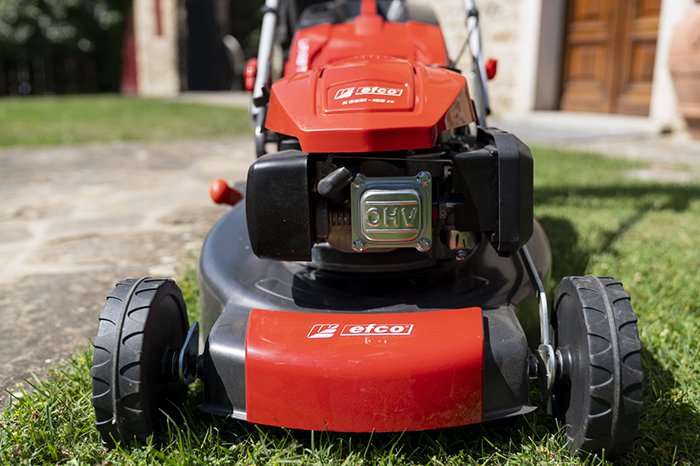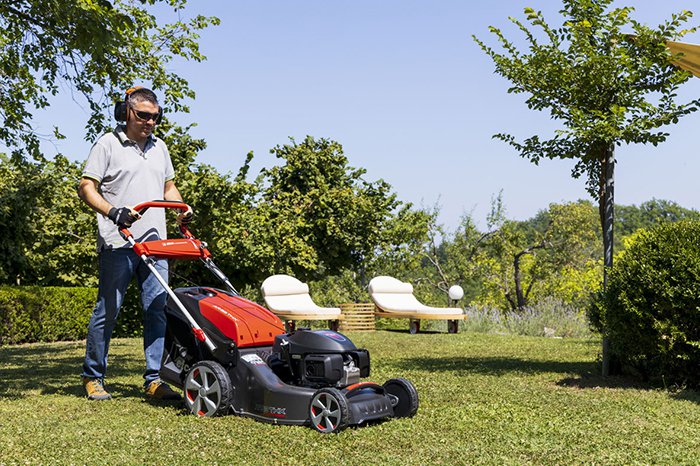Mowing a wet lawn is not advisable, for reasons to do with the lawn itself, the lawnmower and how mowing works. It therefore makes sense to mow when the grass and soil are dry.
Let's see why, for the health of your lawn, it is better not to cut wet grass:
-
The cut will be jagged because the grass is weighed down by the water and put up more resistance to the mower blade, which is also impeded by the clippings caked to the mower deck. A rough cut stresses the grass seedlings and provides an easy point of entry for cryptogamic diseases (i.e. caused by fungi).
-
The weight of the water bends the grass, leading to uneven mowing (this will only be apparent later, once the stems stand back up after drying out).
-
Wet grass gets compacted inside the mower deck, some of which then falls back in small clumps onto the lawn. These clumps must be collected because they cause standing water, form thatch and create the conditions for fungal diseases to thrive. All this negates the benefits of mulching, if your mower has this cutting feature.
-
Moist or sodden soil compresses more easily under a lawnmower’s wheels and due to trampling, with negative consequences for the soil’s structure and fertility, and consequently the health of the lawn.


From a mowing point of view, cutting a wet lawn wastes time and effort. Here's why you shouldn't do it:
-
The lawnmower engine becomes overloaded—especially in the case of less powerful models—because the grass weighs more, exerts greater resistance against the blade and, as already mentioned, sticks to the underside of the cutting deck.
-
The build-up of wet grass under the cutting deck prevents the blade from turning and the mower discharge area becomes clogged: this forces you to stop and clean it, after having switched it off and taken all necessary precautions to avoid accidental starting (such as detaching the cap from the spark plug of petrol engine lawnmowers).
-
Grass is much heavier when it’s wet, so you need to stop working often to empty the grass-catcher.
-
The lawnmower wheels sink into muddy ground and wet grass makes the surface dangerously slippery. By the way, we advise you to wear non-slip footwear.
-
Mud sticks to lawnmowers, shoes, driveways, paths and more, all of which must be cleaned up at the end of the job.
-
Water is an electrical safety hazard for electric and battery-powered lawnmowers. Electric lawnmowers should never be used if the power lead is worn or damaged, especially when the grass is wet. Battery-powered lawnmowers must be protected from moisture to avoid damaging their components and, consequently, endangering the user.
So, in all seasons it is better not to mow grass if it is very wet: never mow in the rain or immediately after rainfall. But what if you really cannot wait until the weather improves? Or if it frequently rains where you are? You can mow the lawn when it is only slightly wet and the ground is not muddy, preferably with a petrol engine lawnmower or, in the case of large areas, with a garden tractor. These considerations for cutting wet grass with a lawnmower also apply to garden tractors.
Before you start mowing, however, let the lawn dry out as much as possible. If it is a small lawn, you can accelerate this process by sweeping it with a broom or using a blower. Mow less than you would if the grass were dry—adhering to the appropriate cutting height for the time of year—and drive the mower forward slowly.
Thinking of buying a mower or replacing the one you have? Check out this overview of lawnmowers, our guide to choosing the right lawnmower and our focus article on self-propelled lawnmowers.
On the other hand, if you are evaluating whether to purchase a garden tractor, here is our guide to choosing a garden tractor and an article on the different tasks that garden tractors can accomplish.





